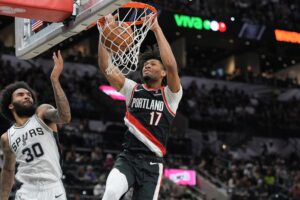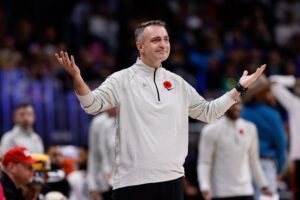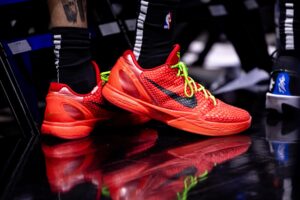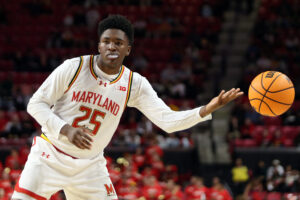Detroit basketball is more than just a phrase; it’s a legacy of toughness, grit, and unrelenting passion. In a city of resilience, Detroit has produced iconic, hardworking basketball players, earning widespread respect and admiration. From the rugged courts of the inner city to the bright lights of the NBA, Detroit’s influence on the game is undeniable. Players live, fight for, and earn every basketball moment with each dribble, pass, and shot.
While Flint and Saginaw often steal the spotlight, Detroit’s basketball scene deserves more recognition. The city’s style, though flashier, still carries that gritty essence. Detroit has produced notable talents like Chris Douglas-Roberts, Manny Harris, and Malik Hairston. These players left their mark in high school, college, and the NBA, embodying Detroit’s resilient spirit. Detroit basketball is a deep-rooted culture, shaping some of the game’s most formidable competitors beyond individual success.
The Grit and Glory of Detroit Basketball: A Legacy Explored
Larger Than Life Detroit Basketball Players
Every city has a player whose legacy transcends time, leaving an enduring mark in local sports history. In Detroit, two such figures are Chris Webber and Robert “Tractor” Traylor. They led high school teams to state championships, won Mr. Basketball in Michigan, starred at U of M, and were key in the Ed Martin scandal. Although Webber and Traylor took different paths in their professional careers, they remain forever entwined in the story of Detroit basketball.
Detroit Public School League Legend
Traylor’s basketball journey began at the legendary Murray-Wright High School, where he made an indelible mark. Traylor was a Class A State Champion, a two-time Detroit Public School League Champion, Mr. Basketball, and a McDonald’s All-American in the same class as future NBA stars Kevin Garnett, Vince Carter, and Paul Pierce. Detroit reporter Terry Foster named Traylor “Tractor” after seeing his dominant play in the state tournament during his junior year.
At Michigan, Traylor played three seasons, averaging 13.3 points, 8.2 rebounds, 1.5 assists, 1.1 steals, and 1.1 blocks. He earned MVP honors in the 1997 NIT and 1998 Big Ten tournaments, but the awards were later forfeited due to the Martin scandal. Despite this setback, Traylor’s talent was undeniable, and the Dallas Mavericks selected him sixth overall in the 1998 NBA Draft.
Traylor played seven NBA seasons with three teams but struggled to maintain a consistent role due to weight issues. After his NBA career, he succeeded overseas, playing in Turkey, Italy, Mexico, and Puerto Rico. He tragically passed away at 34 on May 11, 2011, leaving a legacy that still resonates in Detroit’s basketball circles.
The Best Basketball Prospect From Michigan Since Magic Johnson
Webber was the undisputed number-one player in Detroit and Michigan from the eighth grade. He attended Detroit Country Day High School, a prestigious private school in Beverly Hills, Michigan, where he led the team to three MHSAA state championships. In his senior season, Webber dominated, averaging 29.4 points and 13 rebounds per game, earning him the titles of Mr. Basketball and National High School Player of the Year. His outstanding performance also secured him MVP honors in the McDonald’s All-American and Dapper Dan All-Star games.
Webber joined the University of Michigan’s legendary “Fab 5” with Jalen Rose, Juwan Howard, Jimmy King, and Ray Jackson. Over two seasons, he averaged 17.4 points, 10.0 rebounds, 2.4 assists, 1.5 steals, and 2.5 blocks. His performance earned him Big Ten Freshman of the Year (1992), USWBA Freshman of the Year (1992), and consensus First-Team All-American honors (1993).
NBA Career
With nothing left to prove at the collegiate level, Webber declared for the 1993 NBA Draft. The Magic would select him first overall but then traded him to the Warriors, where he won Rookie of the Year. Throughout his 15-year career, Webber was known for his versatility, basketball IQ, and exceptional passing skills—rare traits for a power forward. His best years were with the Sacramento Kings, where he helped turn the team into a playoff contender in the early 2000s.
Webber was a five-time NBA All-Star and a five-time All-NBA Team selection. He led the Kings to the Western Conference Finals in 2002—a series that remains one of the most memorable in NBA history. Although injuries later hampered his career, Webber still left a lasting legacy as one of his generation’s most skilled and influential power forwards. In 2021, Webber was inducted into the Naismith Memorial Basketball Hall of Fame, cementing his place among the all-time greats.
Detroit Has Produced Solid Guards
Detroit has a rich tradition of producing guards who embody the city’s trademark toughness and versatility. These players are often expected to be leaders on the court, bringing their skills, heart, grit, and relentless work ethic.
“The Ice Man”
George Gervin is one of the most iconic figures in basketball history. His journey began at Martin Luther King Jr. High School, where he emerged as a standout talent. Gervin’s scoring ability was evident from the start, as he averaged over 31 points per game during his senior year, leading his team deep into the state playoffs. His effortless scoring touch and natural athleticism made him a local legend.
After high school, Gervin attended Eastern Michigan University, where he continued to impress. He averaged 26.8 points and 14.4 rebounds during his two seasons with the Eagles. His dominance on both ends of the floor attracted national attention, solidifying his reputation as one of the most talented players in college basketball.
Gervin’s professional career began in the ABA, joining the Virginia Squires in 1972. His impact was immediate; in his first season, he averaged 25.4 points, showcasing his scoring prowess. Over his three seasons in the ABA, Gervin averaged 21.9 points and was known for his smooth shooting and ability to score in bunches.
The Merger
When the ABA merged with the NBA in 1976, Gervin became a star with the San Antonio Spurs. His transition to the NBA was seamless, as he continued to dominate opponents with his signature finger roll and calm demeanor. Gervin won four NBA scoring titles (1978, 1979, 1980, and 1982) and was a nine-time NBA All-Star. During his ten seasons with the Spurs, Gervin averaged 26.3 points, 5.4 rebounds, and 2.8 assists, cementing his status as one of the league’s greatest scorers.
Gervin’s accolades include being named to the All-NBA First Team five times and the All-NBA Second Team twice. His ability to score effortlessly and consistently made him one of his era’s most feared offensive players. In 1996, Gervin was inducted into the Naismith Memorial Basketball Hall of Fame, a fitting tribute to a player whose impact on the game transcended his time on the court. George Gervin’s legacy as “The Iceman” is a testament to his incredible skill, poise, and contribution to the sport.
Southwestern Highschool Legend
Growing up in Detroit, Rose was a standout at Southwestern High School, where he led his team to back-to-back Michigan state championships in 1990 and 1991. His versatility, court vision, and ability to score from anywhere on the floor made him one of the top high school prospects in the country. In his senior year, Rose earned McDonald’s All-American honors.
Rose took his talents to the University of Michigan, where he became a vital member of the legendary “Fab Five.” This group revolutionized college basketball with their baggy shorts, black socks, and swagger, but their on-court performance set them apart. Rose, the team’s primary ball-handler, was the engine that drove the Fab Five’s up-tempo offense. He averaged 17.6 points, 4.7 rebounds, and 4.6 assists over his two seasons with the Wolverines. His ability to play multiple positions—point guard, shooting guard, and small forward—made him a matchup nightmare for opponents.
Rose declared for the 1994 NBA Draft and was selected 13th by the Denver Nuggets. He quickly made a name for himself in the league, bringing his versatile skill set to multiple positions. Rose’s ability to score, distribute, and defend made him a valuable asset wherever he played, and his basketball IQ set him apart as one of the more cerebral players in the league. Over his 13-year NBA career, Rose played for six teams, most notably the Indiana Pacers, where he was a key contributor to their 2000 NBA Finals run.
Rose’s Running Mate
Voshon Leonard attended Southwestern High School, the same as Rose and Howard Eisley. His scoring ability and defensive tenacity helped lead Southwestern to a state championship, earning him All-State honors. Leonard’s reputation as a deadly shooter started early, defined by his ability to perform under pressure.
After high school, Leonard went to the University of Minnesota, where he continued to shine as a prolific scorer. Leonard was a top Big Ten shooter during college, consistently leading in points and three-point shooting percentage. He finished college as the Golden Gophers’ all-time leading scorer and earned First-Team All-Big Ten honors in 1994.
Leonard entered the NBA as an undrafted free agent in 1995, signing with the Milwaukee Bucks before joining the Miami Heat. In Miami, Leonard established himself as a premier three-point shooter, often coming off the bench to provide instant offense. He would become a valuable asset for the Nuggets, where he won the NBA Three-Point Shootout in 2004.
U Of D Legend
Willie Green’s journey began at Detroit’s Cooley High School, where he quickly established himself as a standout guard. His relentless drive on both ends of the court earned him All-State honors and caught the attention of college scouts. He would attend the University of Detroit Mercy, where he became one of the most prolific scorers in the school’s history. Over his four-year college career, Green averaged 17.9 points, leading the Horizon League in scoring during his junior and senior seasons. In 2003, they named him Player of the Year.
Selected 41st overall by the Seattle SuperSonics in the 2003 NBA Draft, Green was traded to the Philadelphia 76ers, where he would begin his professional career. Despite being a second-round pick, Green quickly proved he belonged in the league. His ability to defend multiple positions and his knack for scoring in crucial moments made him a valuable asset. His dedication to taking charges and guarding top players earned him praise from coaches and teammates.
From The Hardwood To The Chalkboard
During his 12-year NBA career, Green played for the 76ers, Hornets, Hawks, Clippers, and Magic. His most productive seasons came with the 76ers, where he averaged double figures in scoring for four consecutive seasons. However, Green’s intangibles—his leadership, professionalism, and commitment to team success—truly set him apart. He was the player who made everyone around him better, often sacrificing his stats for the team’s good.
As head coach of the New Orleans Pelicans, Green shapes the team with the principles that guided his career. With guys like Brandon Ingram and Zion Williamson, Green has been pivotal in their development. His journey from Detroit to the NBA shows the power of perseverance, discipline, and relentless drive.
The Last Word
Detroit’s influence on basketball goes beyond individual achievements; it represents a way of life, showcasing the city’s resilience and grit. Players from Detroit carry a chip on their shoulders, reflecting the challenges of their tough upbringing. Their flashy yet rugged style and blue-collar grit embody Detroit’s essence. This mentality has shaped some of the NBA’s most versatile and tenacious players, leaving a lasting mark on the game.






